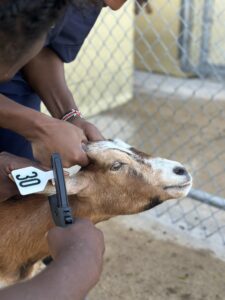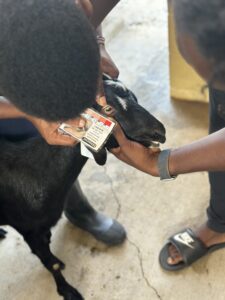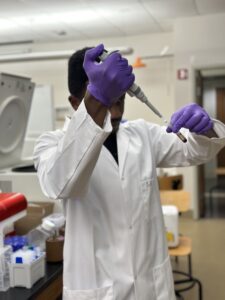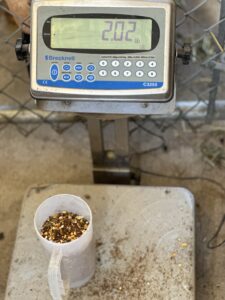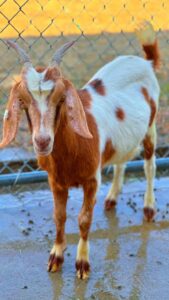Progress report for GS23-294
Project Information
Current disease control programs in livestock, based on anthelmintics and antimicrobial administration, fail due to their reduced effectiveness and resistance in animals. Due to the shortcomings of traditional methods for controlling diseases, a more natural and sustainable way of disease prevention is being explored. Recent studies have shown that some mushrooms possess beneficial health properties, which may improve livestock's immune status if incorporated into their feed regimen. Ganoderma Lucidum is a well-known medicinal mushroom and traditional Chinese medicine, which has been reported to possess immunomodulatory, antioxidant, antitumor, and antiangiogenic properties.
This study aimed to investigate the effect of daily supplementation of GL extracts on biomarkers of immunity and overall health in adult female Spanish goats. Seven adult female Spanish goats received a daily dose(10g) of GL extracts for 60 days. The control group received no GL extracts (n=7). Blood (10ml) and fecal samples were collected on Day 0, Day 30, and Day 60 of the study period. Blood was used to isolate RNA and packed cell volume. Fecal samples were used for microbial DNA isolation and enumeration of parasite eggs. The nanodrop spectrophotometer was used to determine the concentrations and purity of RNA and DNA. Whole blood was centrifuged to form Plasma and cells. RNA was isolated in blood cells using the Trizol method and converted to cDNA. Total plasma protein concentration was determined using BCA assay. A D2Dx immunity kit was used to analyze plasma samples. Quantitative real-time PCR (RT-PCR) was performed using specific primers for TLR2, TLR4, NFKβ1, TNF-α, IL1β, IL10, MPO, SOD2, Bifidobacterium spp, Lactobacillus spp, Bacterium 16S rRNA, Lactoferrin and Lipocalin. Data was analyzed using R studio software (p<0.05). Livak's method was used to calculate fold changes (FC) in relative gene abundance. GAPDH and βactin served as internal controls and for normalization purposes. Fold changes (FC) were considered significant at -2≥FC≥2. Findings did not reveal statistically significant effects of GL supplementation on BW, BC, PCV, FEC, and FAMACHA scores (p≤0.05). GL had an effect on reducing beneficial bacteria in the gut while it significantly increased fold change for TLR2, TLR4, TNF-α, IL10, and MPO. The modulation of these innate immunity genes holds promise in goat health and production.
General objectives
To contribute to the reduction of animal and foodborne related diseases by using natural immunomodulators such as Ganoderma Lucidum to improve gastrointestinal functionality and immune status of goats. The aim is to provide the farmer with a cost-effective, eco-friendly means to help reduce, if not prevent, the incidence of disease in their herd. This project will broadly contribute to efforts to make livestock production safer and more sustainable.
- To investigate the effect of daily supplementation of Ganoderma lucidum on gastrointestinal Nematodes in Spanish goats
- To investigate the effect of daily supplementation of Ganoderma lucidum on systemic innate immune Biomarkers in Spanish goats
- To investigate whether daily supplementation of Ganoderma lucidum reduces oxidative stress by promoting antioxidant production in Spanish goat blood.
Cooperators
Research
Specific Objectives
-
- To investigate the effect of daily Ganoderma lucidum intake on gastrointestinal nematodes in goats. This will be determined by assessing the gastrointestinal nematodes. 2g of fecal sample was collected from goats. McMaster method was used to count fecal egg count (FEC) of Haemonchus contortus. The barber pole worm, or Haemonchus contortus, is one of the main parasites influencing goat output. According to Lima et al. (2013), goats with this blood-sucking parasite living in their abomasum have anemia, weight loss, and impaired production
- To investigate the effect of daily supplementation of Ganoderma lucidum on systemic innate immune response activation in goats. Since Toll-like receptors trigger the innate immunity response, this will be determined by assessing Biomarkers of immunity genes (TLR2, TLR4, NFKB1, tumor necrosis factor-Alpha (TNF-α) and cytokine secretion (IL10), in blood. 10 ml of Blood was collected from the Jugular vein of the goats on day 0, 30 and 60. Centrifugation was done to separate the cells and Plasma. The RNA was isolated from the Cells using Trizol method and converted to cDNA. Gene expression was done using specific primers for the genes involved in TLR pathway. The result from the PCR was analyzed using Livak’s method.
- To investigate whether daily supplementation of Ganoderma lucidum reduces oxidative stress by promoting antioxidant production in goat blood. 10 ml of Blood will be collected from the Jugular vein of the goats on day 0, 30 and 60. Centrifugation was done to separate the cells and Plasma. The RNA was isolated from the Cells using Trizol method and converted to cDNA. Gene expression was done using specific primers for myeloperoxidase (MPO), and superoxide dismutase 2. The result from the PCR were analyzed using Livak’s method.
It is reported that antioxidants protect cellular components from oxidative damage, which can decrease risk of mutations and carcinogenesis and protect the immune cells(Yuen et al., 2011). Oxidative damage is reported to be associated with free radical formation, and oxidative stress which causes health deterioration(Khan et al., 2018).
Methodology
Approval of all protocols for animal handling will be approved by the Institutional Animal Care and Use committee of the University of Arkansas, Pine Bluff (Protocol number: UAPB2019-01).
Experimental Design
Initial screening was conducted to determine body weight, body condition, packed cell volume, Famacha eye score and fecal egg count. Selected goats were randomly assigned to two groups, Treatment, and control group. The treatment group comprised seven goats, while the control group also included seven goats. The treatment group received 10g of Ganoderma lucidum supplement, while the control group did not receive any treatment during the experimental period. Both groups were fed with two pounds of the concentrate and Bermuda hay. Additionally, both treatment and control groups had access to ample water daily. Body weight, body condition score, packed cell volume, Famacha eye score, fecal and blood samples were taken on day 0, 30 and 60.
Body Weight
The initial average body weight of the goats was 61pounds. At the end of the experiment, the average body weight for control and treatment was the same. Ganoderma lucidum had no effect on body weight (p>0.05). At the end of the experiment, the control group had an average body weight of 84.14 pounds which was the same with the treatment group .Similarly, (Mandale et al., 2023) reported mushroom waste had no significant effect on body weight of Berari goats. Although,(W. Lin et al., 2021) reported that 20grams of Ganoderma Lucidium supplemented had an effect on the average weight gain on Anglo-nubian goats. The average weight gain for the treatment group was 3.666kg more than control group. The difference in results could be attributed to the difference in dosage between different experiments, as our study used lower dosage of 10g (Ganoderma lucidum). Body weight is an important parameter in determining health in animals which is important in animal production. Body weight can reduce due to factors such as heat stress, nutrition and parasitic infection.
Body Condition Scores
There was no significant difference between the treatment group body condition and the control group (p>0.05). The body condition ranged from 2-3 which indicates an average healthy animal condition(Ghosh et al., 2019). Body condition is an important tool for farmers to optimize production. It is a simple procedure which can help farmers make management decisions(Ghosh et al., 2019).
Famacha Eye Score
Ganoderma lucidum had no significant effect on the Famacha eye score (p>0.05). The average Famacha score at the end of the experiment was the same for both control and treatment (figure 7). There was no correlation between Famacha eye score and PCV (r= -0.207236). Famacha eye score is an important tool in identifying anemic goats. It is reported that Haemochus contortus is the main cause of anemia in small ruminants (Kaplan et al., 2004). There was no correlation between Famacha eye score and Fecal egg count (r= -0.4667). The goats Famacha eye score ranged from 2-3. Goats with famacha eye score of 3 are considered to be mildly anemic. All the goats appeared to be in good condition and also the overall health. (Kaplan et al., 2004) reports that treatment should be withheld when the scores are low as long as the animal is in good condition and overall health.
Packed Cell Volume (PCV)
At the end of the experiment, there was no significant difference between the control and treatment groups. Ganoderma lucidum did not have a significant effect on the packed cell volume. The control group had an average PCV value of 31%, while the treatment group had an average PCV value of 34% . The values were within the normal range for goats, 22-38% (Elmhurst et al., n.d.). (Kaplan et al., 2004) reported correlation between %PCV and Fecal egg count (FEC). This experiment had no correlation between %PCV and FEC (r= -0.4667). A lower % PCV in goats may indicate anemia, which is undesirable in goat production(Rao et al., 2022).
Fecal Egg Count (FEC)
This experiment tested Haemonchus contortus eggs which were found in fecal samples. There was no significant difference between control and treatment groups. Ganoderma lucidum had no significant effect on the fecal egg count at the end of the experiment. The average FEC across the treatment was 643 EPG . It is reported that 500 to 1000 EPG is indicative of subclinical parasitic gastroenteritis(Taylor, 2002). Haemonchus contortus is reported to be a blood-sucking nematode, which can cause acute anemia leading to death in goats, especially in heavy infections(Taylor, 2002).
Microbial DNA in Fecal samples
Microbial DNA samples were used to determine the microbial population in the rumen of goats. There was no significant difference in microbial DNA concentration between the control and treatment groups at the end of the experiment (p= 0.44015). Ganoderma lucidum has no significant effect on microbial DNA concentration. There was an observable increase trend of Microbial DNA concentration from day 0 to day 60 for both the control and treatment groups.
RNA Concentration
The RNA concentrations were tested to determine the amount of mRNA in samples, which influences the gene expression level. There was no significant difference between the control and treatment groups (p= 0.2336). There was an observable decrease in RNA concentration from day 0 to day 60 for both the control and treatment groups. Although, treatment tended to increase the RNA concentration . It is reported that Ganoderma lucidum polysaccharides increased nuclear DNA and RNA contents in murine splenocytes(Z. Lin & Zhang, 2004).
Total Protein Concentration
There was no significant difference between the control and treatment groups (P=0.1880). There was an increasing trend in total protein concentrations due to the effect of Ganoderma lucidum. This could be because of the immunomodulatory effect of Ganoderma lucidum. It is reported that the immunomodulatory effect of the mushroom Agaricus blazei increased the plasma proteins(Johnson et al., 2009).
D2Dx Analysis
There was no significant difference between control and treatment group after day 60 (p=0.6754). The D2Dx is used to detect antibody-mediated immune responses which uses a gold nanoparticle (AuNP) as a pathogen substitute to probe the humoral immunity in blood plasma or serum(Deb et al., 2021; Zheng et al., 2020). A high D2Dx test score is reported to indicate stronger type 1 immunity and a weaker type 2 immunity(Deb et al., 2021). Research shows that Th1 is more protective against intracellular pathogens such as viruses while Th2 is more protective against extracellular pathogens such as parasites.(Zheng et al., 2020). It is reported that D2Dx immunity kit was able to detect differences in components of humoral immunity in both mouse model and bovine samples(Zheng et al., 2020).
Amplified Primers on agarose gel
The Genes tested in the goat blood were amplified on a 2% agarose gel at the expected base pair. (Fig 14). However, TNF, IL1β and MPO tested in blood were not amplified . The genes tested in Microbial DNA (Bifidobacterium spp, Lactobacillus spp, Bacterial 16S rRNA, Lipocalin2 and Lactoferrin) were not amplified at 2% agarose gel.
Effect of Ganoderma lucidum on Gene Expression
Gene Expression from Blood Cells
Ganoderma lucidum modulated expression of genes after day 60 of supplementation. Seven genes (7) were upregulated (TLR2, TLR4, TNF-α, IL10, MPO, IL1β, and NFKβ1), while only one (1) gene was downregulated (SOD1). Fold changes above or equal to ±2 were considered significant.
Fold change in Biomarkers of immunity after 60 days of Ganoderma lucidum supplementation in Spanish goats
|
Gene |
Gene Functiona |
Fold Changeb |
|
TLR2 |
Plays a role in pathogen recognition and activation of innate immunity. Detects Lipoproteins |
2.7 |
|
TLR4 |
Plays a role in pathogen recognition and activation of innate immunity. It detects lipopolysaccharides (LPS) |
2.0 |
|
NFKβ1 |
It regulates the expression of genes involved with Inflammation |
1.2 |
|
TNF-α |
It's involved in inflammation and is produced by immune cells in response to infection, injury, or other immune challenges |
2.6 |
|
IL10 |
It helps to dampen excessive inflammation and maintain immune homeostasis. |
2.1 |
|
MPO |
It's an enzyme produced by neutrophils, a type of white blood cell involved in the immune response |
19.2 |
|
SOD1 |
Its acts as an antioxidant by removing free radicals in the body specifically superoxide radicals |
-1.8 |
a Gene function information is from Gene Cards (https://www.genecards.org)
b Fold change of ≥±2; p<0.05 was considered significant (Downregulation (-), Upregulation (+)
It is reported that mushrooms which have β-glucans as their major component appear to have an important role in the innate immune response (Ekwemalor et al., 2016). Ganoderma lucidum appears to stimulate both pro-inflammatory (TNF α, IL1β) and anti-inflammatory (IL10) responses, which can be beneficial for mounting effective immune responses while preventing excessive inflammation. Another study reported that β-glucan had an effect on decreasing IL1β in mice(J. Lin et al., 2013). A fold change increase in TLR2 (2.7) and TLR4(2.0) indicates an increase in pathogen recognition capacity. It is reported that innate immunity can be stimulated by the activation of pattern recognition receptors (PRR), which recognize pathogen-associated molecular patterns (PAMPs) and mediate the production of cytokines(Ekwemalor et al., 2016). Studies have shown that TLR2 and TLR4 are the most studied TLRs, mediating responses to gram-positive and gram-negative bacteria(Prince et al., 2011). It is reported that β-glucan from Ganoderma lucidum increased the expression of TLR2, TLR4, and TNF(Batbayar et al., 2011). Similarly, (Ekwemalor et al., 2016) observed an increase in TLR2 and TLR4 due to the mushroom (Coriolus versicolor) effect. A 1.2-fold change increase in NFKβ1 due to Ganoderma lucidum effect may contribute to inflammatory regulation. An increased fold change in MPO (19.2) suggested activation of neutrophil and immune response. A decrease in SOD1 fold change may indicate reduced antioxidant capacity.
In this study, Ganoderma lucidum modulated toll-like receptors (TLR2, TLR4) and pro-inflammatory and anti-inflammatory cytokines, which are critical in goat health and the modulation of innate immunity.
Gene Expression from Microbial Fecal DNA
Ganoderma lucidum had no significant effect (p>0.05) on the gastrointestinal genes (Lactobacillus spp, Bacterial 16S rRNA, Lactoferrin, and Lipocalin). However, there was a significant fold change in the downregulation of Bifidobacterium spp (-2.1).
Fold change in Gut microbiota composition after 60 days of Ganoderma lucidum supplementation in Spanish goats
|
Gene |
Gene Functiona |
Fold Changeb |
|
Bifidobacterium spp |
Beneficial bacteria in the gut whose increase indicates a healthy gut |
-2.1 |
|
Lactobacillus spp |
Beneficial bacteria in the gut whose increase indicates a healthy gut |
-1.5 |
|
Bacterial 16S rRNA |
A component of the bacterial ribosome is used as a marker for testing total bacteria. |
1.1 |
|
Lactoferrin |
Maintains gastrointestinal health by promoting beneficial gut bacteria |
-1.7 |
|
Lipocalin 2 |
It's involved in transporting iron and apoptosis of bacteria by depriving them iron which they need to survive. |
-1.1 |
a Gene function information is from Gene Cards (https://www.genecards.org)
b Fold change of ≥±2; p<0.05 was considered significant (Downregulation (-), Upregulation (+)
Research shows that β-glucan key biological activities include anti-inflammatory, antioxidant, and immunomodulatory effects, which can positively influence the gut microbiota through increased Lactobacillus and Bifidobacteria populations(Dowley et al., 2021). This is supported by previous research conducted by (Giannenas et al., 2010, 2011), who reported that Agaricus bisporus mushroom had an effect on increasing Bifidobacteria and Lactobacillus populations.
Lactobacillus and Bifidobacteria are reported to compete against potential pathogens for nutrients and binding sites, causing a reduction in the intestinal population of pathogens and thereby improving gastrointestinal function(Giannenas et al., 2011). However, in our studies, we found that Ganoderma lucidum mushroom had a significant effect on reducing the number of Bifidobacteria species. It is possible that Ganoderma lucidum supplementation could be associated with the change in the gut microbial composition, potentially favoring the growth of other microorganisms in the gut, leading to a decrease in Bifidobacteria species. However, further studies on the effect of Ganoderma lucidum mushroom on gut microbiota in goats may provide more insights into these changes.
Educational & Outreach Activities
Participation Summary:
Still working on the thesis and therefore not yet published to journal articles. I have presented in PAWC 2023 in Tuskegee university and I'm also going to present in ARD 2024 in Nashville on 6th April
Project Outcomes
Our research has generated data on the potential immunomodulatory activities of Ganoderma lucidum supplementation in goats which can be used to promote health and performance in animal production. This will reduce reliance on use of chemical drugs like antibiotics which is a food safety and public health concern. The project will also provide farmers with a cost-effective, eco-friendly means to help reduce, if not prevent, the incidence of disease in their herd.
Throughout the project our understanding and appreciation for sustainable agriculture has increased. We gained more knowledge about role of Ganoderma lucidum and how it modulates the immune system which can help to reduce reliance on chemical drugs like antibiotics and anthelmintics in goat production providing a safer alternative. We also honed our laboratory skills doing this work which can be used in future projects for sustainable agriculture. We have gained more insights on environment sustainability and food safety which we are committed to implement in our research and beyond.
